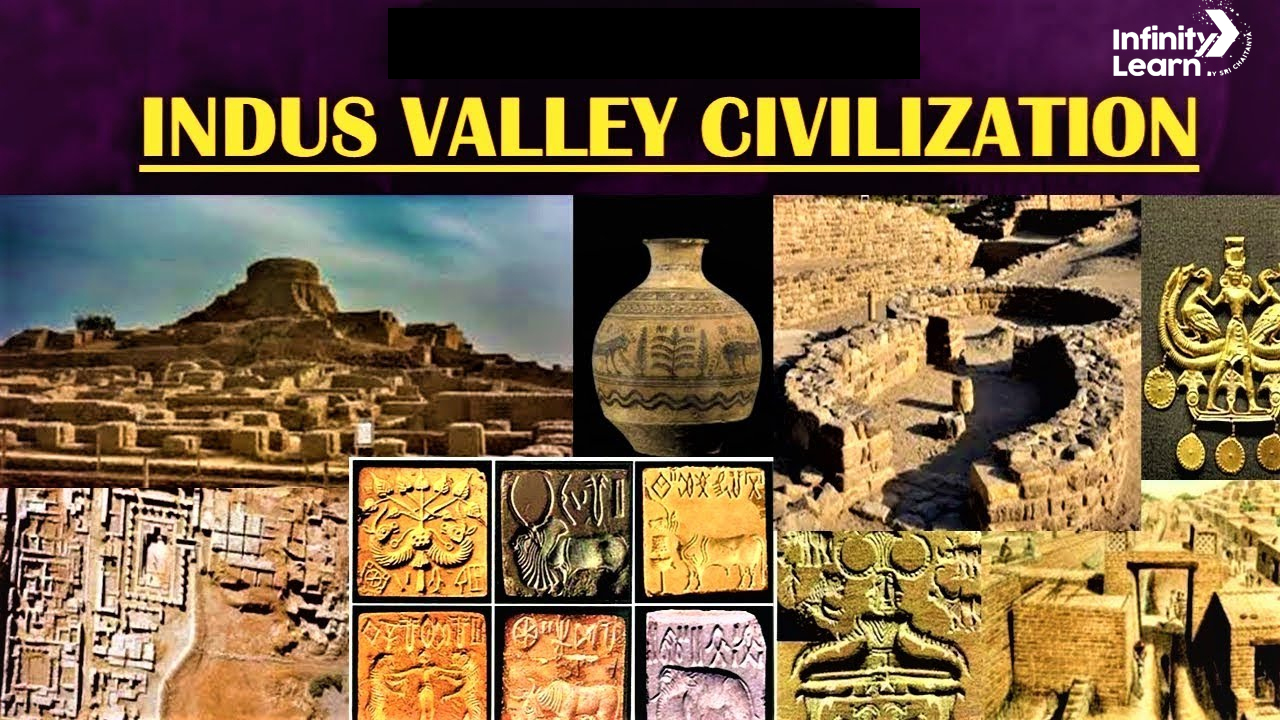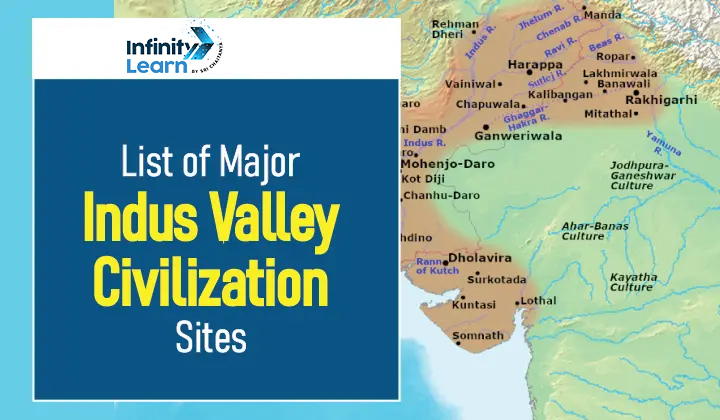Table of Contents
The Indus valley civilization, also known as the Harappan civilisation, represents the earliest urban culture in the Indian subcontinent. The Indus Valley Civilization Time Period is said to be from 2500 to 1700 BCE, with some southern sites possibly lasting into the 2nd millennium BCE. Among the world’s earliest civilisations, including Mesopotamia and Egypt, the Indus Valley Civilization was the most widespread and extensive.
This article will discuss the Indus Valley Civilization in brief. Read till the end to know more about the Indus Valley Civilization, its origin and location, planning and more.
Indus Valley Civilization Origin And Location
The Indus Valley Civilization was the earliest known urban culture in the Indian subcontinent. Indus Valley Civilization was first identified in 1921 at Harappa in the Punjab region and then in 1922 at Mohenjo-daro, near the Indus River in the Sindh region. Both sites are located in present-day Pakistan. The ruins of Mohenjo-daro were designated a UNESCO World Heritage site in 1980.

Location of Indus Valley Civilization
The Indus Valley Civilization’s vestiges were discovered at various sites, including Sutkagen Dor in southwestern Balochistan province, Ropar in eastern Punjab state (northwestern India), down the west coast of India to the Gulf of Khambhat, and as far east as the Yamuna River basin.
The Indus Valley Civilization comprised two major cities, Harappa and Mohenjo-daro, and more than 100 towns and villages. The cities were possibly about 1 mile square, suggesting political centralisation. The population was around 23,500–35,000 in Harappa and 35,000–41,250 in Mohenjo-daro. The Indus Valley Civilization relied on irrigated agriculture and domesticated animals such as cattle, dogs, cats, fowl, and elephants. The people cultivated crops like wheat, barley, peas, mustard, sesame, and cotton. The Indus Valley Civilization’s success was rooted in its ability to harness the fertile Indus River valley while managing the annual floods.
Indus Valley Civilization Sites
The Indus Valley Civilization had several important sites. Some of these include:
- Harappa and Mohenjodaro, presently located in modern-day Pakistan
- Lothal and Dholavira in Gujarat.
- Kalibangan and Balathal in Rajasthan.
- Rakhigarhi in Haryana.
- Ropar, now in Punjab.
Indus Valley Civilization Map

Indus Valley Civilization Urban Planning
Urban planning in the Harappan Civilization was highly advanced. The cities exhibited well-organized layouts, with houses made of sun-dried and burnt bricks. The houses were typically one or two-storeyed and featured separate bathing areas. A notable aspect was the presence of wells in each house. The urban dwellings had a sophisticated drainage system interconnected with the street drainage. The streets were systematically planned, incorporating waste disposal, lighting, drainage, and water supply systems. The overall infrastructure and planning in Harappan cities reflected a high level of urban sophistication for its time.
Script And Language of Indus Valley Civilization
The Indus Valley Civilization, marked by its extensive trade contacts and a well-developed state, had a script that remains undeciphered. The language is unknown, but recent analyses suggest a possible relation to the Dravidian language family, with the Brahui language in western Pakistan showing some connection. The script, written from right to left, comprises over 500 signs with unclear ideographic or logographic properties. Despite decades of study, no consensus on reading the script has been reached.
The Harappans utilised systems of weights and measures. While early analyses proposed binary and decimal systems, recent research suggests a more complex decimal-based system. Multiple scales of measurement, including a decimal scale and a bronze rod marking lengths, were found. These units, such as the “foot” and “cubit,” were widely used in Western Asia and Egypt, indicating advanced understanding and application in the Indus Valley Civilization. Additionally, objects resembling optical squares have been theorised as tools for surveyors, aligning with the precision observed in the Indus Valley Civilization’s architectural work.
Indus Valley Civilization: Art And Craftsmanship
The Indus Valley Civilization revealed various aspects of artistic activity through excavations of its cities. Stone sculpture was rare and often crude, with seated men, composite animals, and unique instances like a standing nude male and a dancing figure. Cast-bronze figures, including dancing girls, small chariots, and animals, showcased technical excellence but were limited in number. Terra-cotta figurines, particularly standing females heavily adorned with jewellery, constituted popular art, possibly representing deities. Small seals, primarily depicting humpless “unicorns” or bulls, were widely diffused, likely serving as amulets or identification devices for merchandise.
Copper and bronze were key metals for tools, including axes, chisels, knives, and saws. Bronze vessels were among the finest products, formed by hammering metal sheets, while figurines were made using the lost-wax process. Other metals like gold, silver, and lead were used for various objects. Special crafts included faience manufacturing for beads and amulets, stone carving for seals, and textile production, evidenced by fragments of cotton textiles at Mohenjo-Daro, showcasing an early industry in India.
Pottery included wheel-thrown and painted varieties with geometric patterns. A notable vessel form was the offering stand and a mysterious cylindrical vessel with perforations. Fragments of cotton textiles, demonstrating an ancient industry, were found at Mohenjo-daro. Stone, despite its scarcity in the alluvial plain, played a crucial role, sourced from peripheral areas and utilised for tools like blades and artefacts.
Drainage System Of Indus Valley Civilization
The Harappan city of the Indus Valley Civilization exhibited meticulous urban planning, featuring two distinct parts: the upper city or Citadel, where the elite class resided, and the lower town, where common people lived. The streets were wide and straight, intersecting at right angles. Houses varied in size, constructed using baked bricks and wood. Large houses were multi-roomed, sometimes double-storied, with courtyards and wells. Small houses typically had one or two rooms, each equipped with a kitchen and bathroom.
The drainage System Of the Indus Valley Civilization was advanced. The Indus Valley Civilization boasted an advanced drainage system with covered drains along the streets. House drains connected to these street drains, which are ultimately linked to the main underground drain, efficiently channelling wastewater out of the city. Remarkable architectural structures like the Great Bath at Mohenjodaro and the granary at Harappa showcased the engineering prowess of the Harappans.
Decline Of Indus Valley Civilization
The decline of the Indus Valley Civilization remains uncertain, occurring in several stages over approximately a century, estimated between 2000 and 1750 BCE. The collapse of the urban system did not necessarily mean a complete breakdown in the lifestyle of the population across the entire Indus region. However, it marked the end of the cities, their distinctive urban traits, and social and political control systems.
Mohenjo-daro, one of the major cities, experienced a sudden and dramatic end. Around the middle of the 2nd millennium BCE, the city was attacked by raiders who left the dead where they fell. The attackers’ identity is speculative, but it aligns with the historical narrative of earlier invaders from the north, possibly Indo-European speakers. Mohenjo-daro was already in an advanced stage of decline before the attack, facing challenges like floods, shoddy construction, and overcrowding.
Following the decline of the Indus Valley Civilization, impoverished cultures succeeded in the Indus Valley. In the northwest, urban civilisation ceased for many centuries, while in the south, there was cultural continuity between the late Indus phase and Copper Age cultures in central and western India from 1700 to the 1st millennium BCE. These cultures served as a bridge between the end of the Indus civilisation and the emergence of the developed Iron Age civilisation in India around 1000 BCE.
FAQs on Indus Valley Civilization
What is the Indus Valley Civilization known for?
The Indus Valley Civilization is known for its advanced urban planning, drainage systems, and distinctive artefacts, including seals and statuary. It had well-organized cities and trade networks.
Who is the founder of the Indus Valley Civilization?
The founder of the Indus Valley Civilization is unknown. It developed organically as an indigenous culture in the Indian subcontinent.
How did the Indus Valley Civilization start and end?
The exact origins of the Indus Valley Civilization are not clear, but it is believed to have emerged around 3300 BCE. The decline and end of the Indus Valley Civilization around 1300 BCE are attributed to factors like environmental changes, natural disasters, and possibly invasions.
Is Indus Valley Civilization still exist?
No, the Indus Valley Civilization is not still in existence. It declined around 1300 BCE, likely due to a combination of factors such as environmental changes and invasions.
Who is the first founder of Indus Valley Civilization?
The founders of the Indus Valley Civilization remain unknown. It was likely established by a group of people who settled in the fertile Indus River Valley region.
What is known about the Indus Valley Civilization?
The Indus Valley Civilization was an ancient civilization that thrived around 3300–1300 BCE. It was known for its advanced urban planning, drainage systems, and trade networks.









